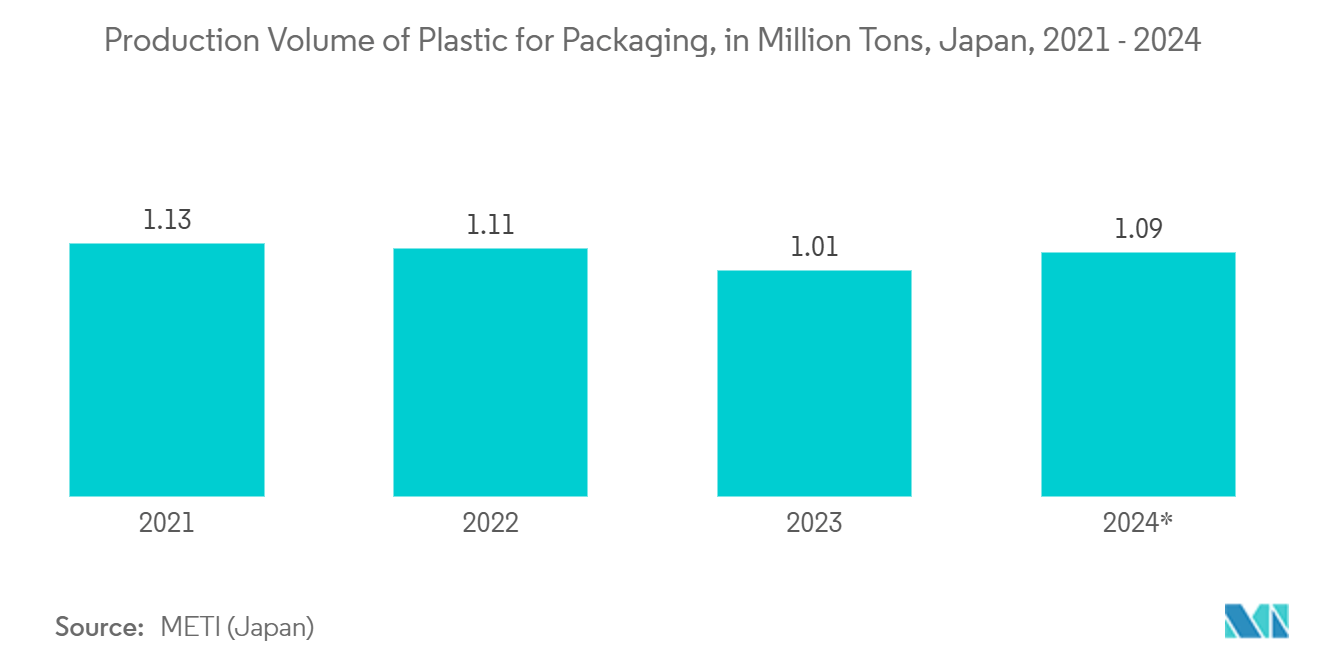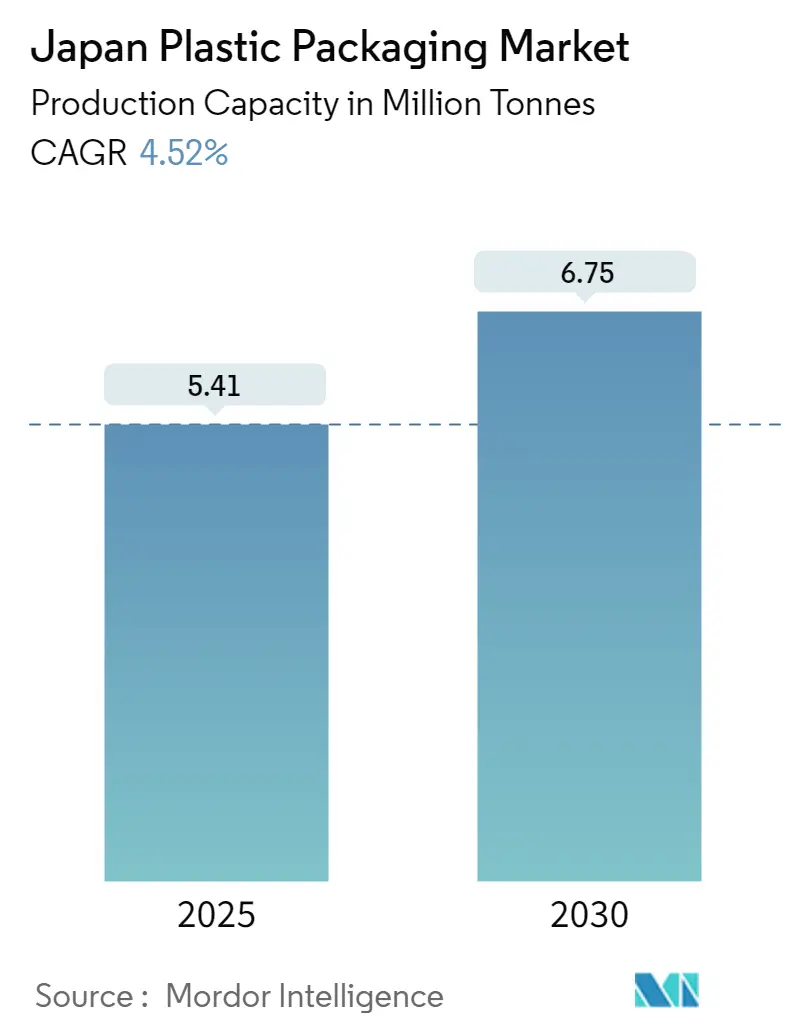
| Study Period | 2019 - 2030 |
| Base Year For Estimation | 2024 |
| Forecast Data Period | 2025 - 2030 |
| Market Volume (2025) | 5.41 Million tonnes |
| Market Volume (2030) | 6.75 Million tonnes |
| CAGR | 4.52 % |
| Market Concentration | Medium |
Major Players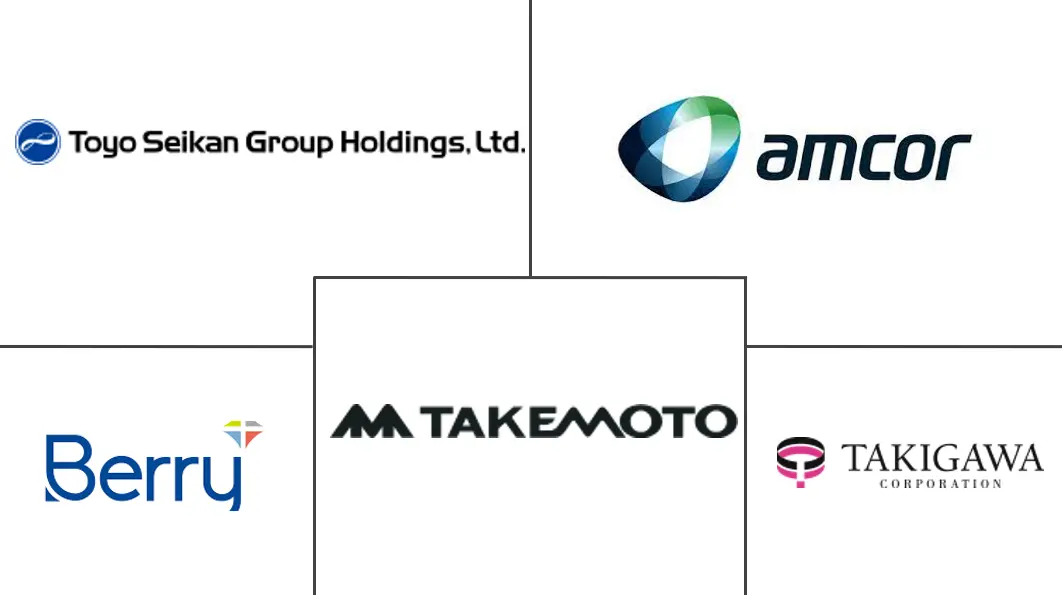
*Disclaimer: Major Players sorted in no particular order |
Japan Plastic Packaging Market Analysis
The Japan Plastic Packaging Market size in terms of production capacity is expected to grow from 5.41 million tonnes in 2025 to 6.75 million tonnes by 2030, at a CAGR of 4.52% during the forecast period (2025-2030).
The food and beverage industry drives the plastic packaging market in Japan. Consumers favor plastic packaging for its lightweight and unbreakable nature, enhancing ease of handling.
- In Japan, consumers favor plastic packaging for its durability, flexibility, and cost-effectiveness. This packaging form employs plastic films, containers, and other polymer-based materials, creating a barrier against external elements. This versatility makes it a lightweight solution for packaging various goods. Industries such as beverage, food, cosmetics, and pharmaceuticals increasingly rely on plastic container packaging, which drives the product demand.
- Japanese manufacturers of plastic packaging are poised for substantial growth by focusing on the development of both rigid and flexible packaging solutions tailored to diverse end-use industries. In October 2024, Toppan Inc., in collaboration with RM Tohcello Co. Ltd. and Mitsui Chemicals Inc., has successfully created a recycled BOPP film primed for mass production. Starting October 2024, these companies will commence the distribution of samples for this innovative film.
- New filling technologies and the advent of heat-resistant PET bottles have broadened market possibilities in the country. In response to rising demand, beverage manufacturers are ramping up PET bottle production in Japan.
- In September 2024, Coca-Cola Bottlers Japan Inc. (CCBJI) unveiled a new aseptic production line at its Tokai Plant in Aichi Prefecture. This line boasts a production capacity of around 600 small PET bottles per minute, bolstering CCBJI's ability to meet surging demand.
- However, a surge in plastic waste has led Japanese consumers to gravitate towards eco-friendlier packaging materials such as glass and metal. The region has seen a notable uptick in the adoption of aluminum and glass, celebrated for their recyclability and eco-friendly attributes. This shift away from plastic could pose challenges for product demand in the future.
Japan Plastic Packaging Market Trends
Bottles and Jars Segment is Expected to Dominate the Market
- The lightweight nature of plastics fuels their rising demand. In Japan, the food and beverage sector's increasing reliance on plastic bottles and jars propels the need for plastic packaging.
- Plastic bottles extend their utility beyond beverages, finding prominence in Japan's cosmetics and pharmaceuticals sectors. Market dynamics are evolving with innovations like advanced filling technologies and the launch of heat-resistant PET bottles. While PET bottles lead in various sectors, polyethylene (PE) bottles are the preferred choice for beverages, cosmetics, sanitary items, and household items such as detergents.
- Japanese companies are increasingly producing PET bottles for beverages, a trend poised to fuel market growth. In March 2024, Otsuka Foods Co., Ltd., a prominent player based in Japan, unveiled its plans to launch two new products in its MATCH line of carbonated vitamin drinks: MATCH Pineapple Soda in a 500-ml PET bottle and MATCH Jelly in a 260-gram PET bottle in the Japanese market.
- The Japan Soft Drink Association has set an ambitious goal of achieving 50% bottle-to-bottle recycling by 2030. Industry players are lightening the weight of PET bottles to reduce the amount of PET resin used. Data from the Japan Soft Drink Association (JSDA) highlights that PET bottles have overtaken steel and glass in the country's non-alcoholic beverage sector. Furthermore, stringent government regulations have positioned Japan as a global leader in PET bottle collection and recycling, a factor poised to stimulate market growth.
- As reported by the Ministry of Economy, Trade and Industry (METI) Japan, the country's plastic packaging production saw a dip of 0.1 million tons (-9.01 percent) in 2023 compared to the prior year. However, projections indicate a rebound to 1.09 million tons in 2024, signaling potential market growth.
Beverage Industry Set for Significant Growth
- Japan's beverage industry is expanding significantly, fueled by a rising demand for health-oriented drinks. Consumers are increasingly gravitating towards beverages that promise health benefits, including immunity enhancement, better digestion, and sharper cognitive functions. This trend is especially evident among the elderly and those facing health challenges linked to their lifestyles.
- In Japan, rigid plastic packaging, commonly found in plastic bottles and containers, is widely favored for food and beverage applications. The demand for these products is notably driven by the use of HDPE and PET bottles for packaging juices, carbonated soft drinks, and other beverages. Notably, manufacturers such as Toyo Seikan Co. Ltd. are producing heat and pressure-resistant PET bottles tailored specifically for beverage applications.
- Innovations are reshaping Japan's beverage landscape, with a focus on merging natural ingredients and scientific advancements. In 2024, segments such as soft drinks, sports drinks, and energy drinks are poised to showcase the varied consumer preferences for functional beverages. By prioritizing innovation, targeted marketing, and sustainability, companies can cement their foothold in Japan's burgeoning functional beverage arena.
- Additionally, data from the US Department of Agriculture (USDA) reveals that Japan's non-alcoholic beverage market was valued at approximately USD 40 billion in 2023, with imports accounting for about USD 1 billion. The U.S. stands as Japan's chief supplier of non-alcoholic drinks, with exports predominantly comprising mineral water and juices. Healthy beverages and non-alcoholic beers are emerging as leading consumer trends, significantly influencing the demand for plastic packaging.
- Japan's surging appetite for non-alcoholic drinks is bolstering its plastic packaging sector. As reported by Asahi Group Holdings, a prominent Japanese firm, Ready-to-Drink (RTD) tea led the soft drinks segment in 2023, capturing roughly 30% of sales. The diverse range of non-alcoholic beverages in Japan is driving a heightened demand for both rigid and flexible packaging solutions in the nation.
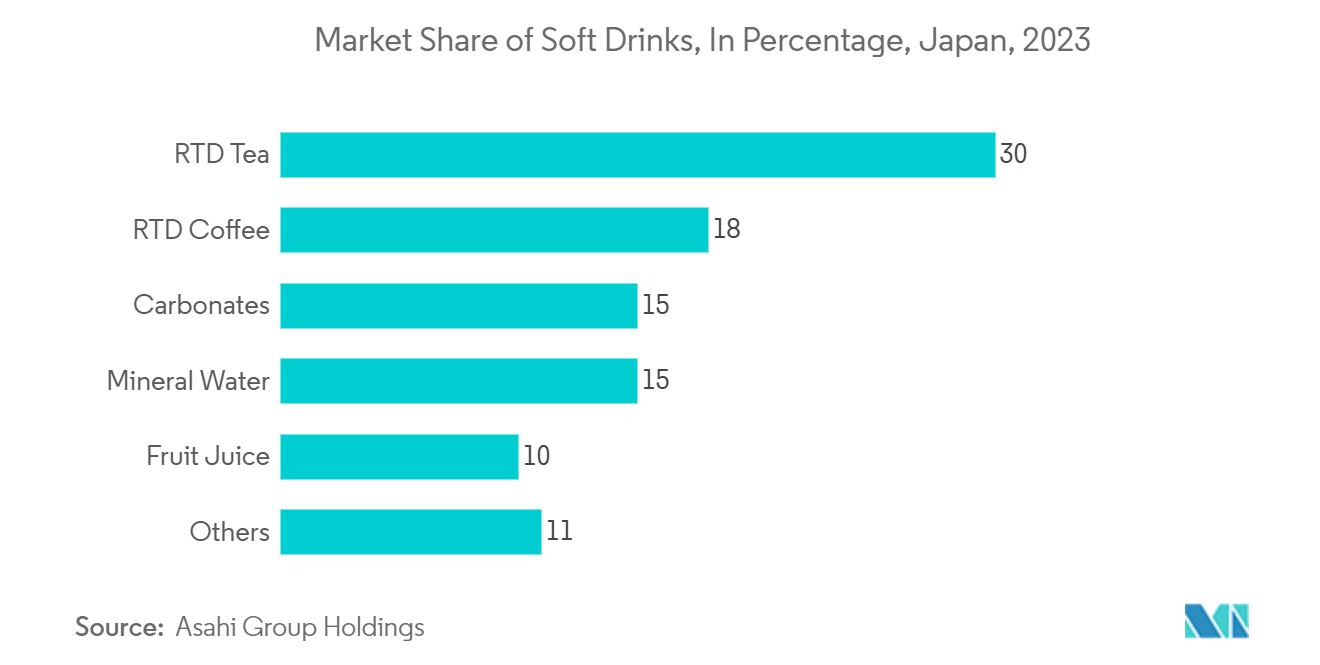
Japan Plastic Packaging Industry Overview
The Japanese plastic packaging market is moderately consolidated with the presence of global and domestic players such as Amcor Group, Takemoto Yohki Co. Ltd, Toyo Seikan Group Holdings Ltd, Berry Global Inc. and Takigawa Corporation. These companies are actively pursuing strategies such as product innovations, collaborations, mergers and acquisitions, and investments to expand their business and capture a larger market share.
Japan Plastic Packaging Market Leaders
-
Toyo Seikan Group Holdings, Ltd.
-
Takemoto Yohki Co. Ltd.
-
Takigawa Corporation
-
Amcor Group
-
Berry Global Inc.
- *Disclaimer: Major Players sorted in no particular order
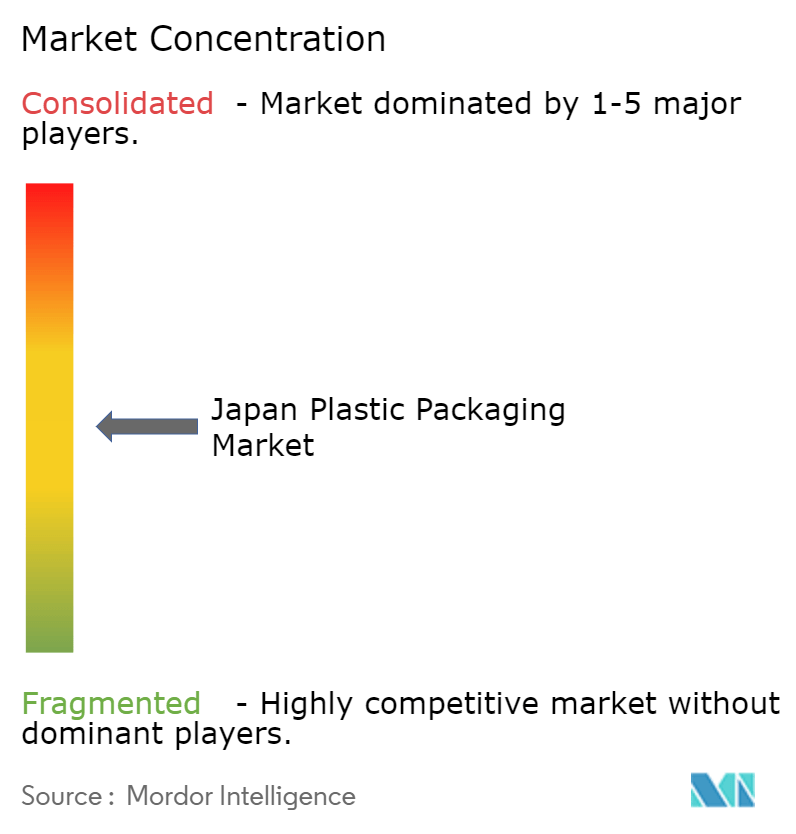
Japan Plastic Packaging Market News
- September 2024: Berlin Packaging, a United States-based company, acquired Nissho Jitsugyo Co., Ltd. This Japanese company supplies packaging products and services to a variety of markets across the country. With this acquisition, Berlin Packaging aims to bolster its presence in the Asia-Pacific region and enhance its ability to serve customers in Japan using its global packaging solutions.
- June 2024: Takemoto Yohki Co. Ltd., a Japan-based company, expanded its lineup of hot fill-compatible PET bottles. In addition to its existing 720 ml and 900 ml bottles, the company has rolled out a new 500 ml variant. These bottles boast a uniquely designed panel with smooth, elegant curves for better handling. Designed to endure hot fills of up to 90°C, they're perfect for juices, soft drinks, and sweet beverages.
Japan Plastic Packaging Industry Segmentation
Lightweight plastic cuts down on transportation costs and energy consumption. Its durability safeguards products from damage during shipping and handling. By forming a barrier against moisture, air, and contaminants, plastic packaging not only keeps food and other items fresh but also extends their shelf life. The research also examines underlying growth influencers and significant industry vendors, all of which help to support market estimates and growth rates throughout the anticipated period. The market estimates and projections are based on the base year factors and arrived at top-down and bottom-up approaches.
Japan Plastic Packaging Market is Segmented by Type (Rigid Plastic, Flexible Plastic), by End-User Industry (Food, Beverage, Healthcare, Personal Care and Household), and by Products (Bottles, Jars, Pouches, Trays, Containers, Bags, Films, Wraps). The Market Sizes and Forecasts are Provided in Terms of Volume (Tonnes) for all the Above Segments.
Japan Plastic Packaging Market Research FAQs
How big is the Japan Plastic Packaging Market?
The Japan Plastic Packaging Market size is expected to reach 5.41 million tonnes in 2025 and grow at a CAGR of 4.52% to reach 6.75 million tonnes by 2030.
What is the current Japan Plastic Packaging Market size?
In 2025, the Japan Plastic Packaging Market size is expected to reach 5.41 million tonnes.
Who are the key players in Japan Plastic Packaging Market?
Toyo Seikan Group Holdings, Ltd., Takemoto Yohki Co. Ltd., Takigawa Corporation, Amcor Group and Berry Global Inc. are the major companies operating in the Japan Plastic Packaging Market.
What years does this Japan Plastic Packaging Market cover, and what was the market size in 2024?
In 2024, the Japan Plastic Packaging Market size was estimated at 5.17 million tonnes. The report covers the Japan Plastic Packaging Market historical market size for years: 2019, 2020, 2021, 2022, 2023 and 2024. The report also forecasts the Japan Plastic Packaging Market size for years: 2025, 2026, 2027, 2028, 2029 and 2030.
Our Best Selling Reports
Japanese Plastic Packaging Industry Report
Statistics for the 2025 Japan Plastic Packaging market share, size and revenue growth rate, created by Mordor Intelligence™ Industry Reports. Japan Plastic Packaging analysis includes a market forecast outlook for 2025 to 2030 and historical overview. Get a sample of this industry analysis as a free report PDF download.



